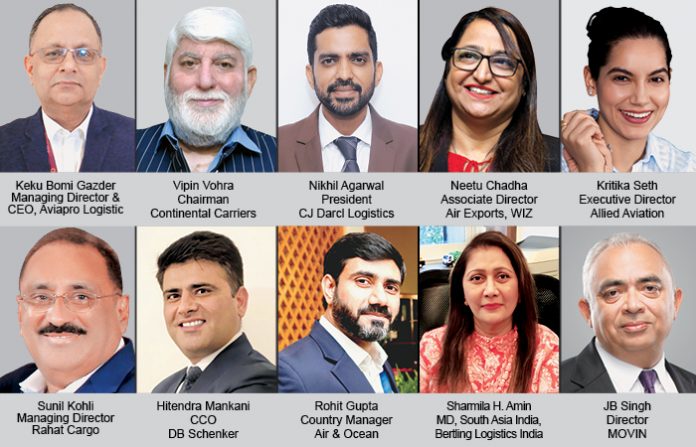Air freight traffic rose by 3.2% in 2022-23, indicating a marginal growth. The industry is driven by high demand in e-commerce, pharma, manufacturing, electronics, and agro. Future growth can be facilitated by establishing advanced air cargo terminals, belly capacity expansion, and recruiting dedicated cargo freighters.
Ritika Arora Bhola
Ever since COVID has hit the world, the demand for pharma and perishables have witnessed a surge. Industry leaders have learnt an important lesson—to be prepared for the worst and have contingency plans in place to survive.
The world knows pharma and perishables are the lone commodities, which were moving, when the world came to a standstill. The demand for pharma—medicines, clinical equipment—and perishables would never see a downturn. These apart, import commodities comprise petroleum products, electronics, gold, silver, aluminium, copper, lead, nickel, zinc, crude oil, natural gas, cardamom, cotton, crude palm oil, kapas, mentha oil, rubber, and machinery goods and pulses and rice depending on the situation.
The air cargo industry has recently witnessed a high growth in transporting high-value goods, pharmaceuticals, and temperature-sensitive products, thereby focusing on the air cargo services in ensuring secure transportation followed by efficient deliveries at the click of a mouse.
If we talk about future commodities, pharma and perishables would take a lead followed by the e-commerce which has brought a revolution in logistics and contributed to its growth. Since 2020, e-commerce is flourishing. It is driving cargo growth incredibly. In the past, with internet penetration and exposure, e-commerce has reached the remotest areas, assuring same day and next day deliveries.
From 2020-2022, demand for consumer durables has also increased significantly. Since 2023, the industry is witnessing demand for sustainable goods.
Government initiatives
The government’s support in improving customs processes and collaboration across the cargo supply chain could enhance efficiency and contribute to reaching the target of 10 MMT by 2030.
The Indian government is focusing on advancing cargo, logistics and e-commerce to boost economic development and making it a `5 trillion economy. Developments such as infra boost, NLP, digitalisation, e-commerce regulations, customs reforms, support for startups, and GST implementation are reaffirming the same for the sector. These efforts align with ‘Make in India’ and ‘Atmanirbhar Bharat’, stressing self-reliance and promoting a conducive environment for these sectors to thrive. It is vital to have rules and norms in place that could encourage exporters achieve optimal productivity in maximising exports.
We expect the government to drive essential regulatory reforms through the PM Gati Shakti Masterplan and National Logistics Policy to establish a global standard air logistics ecosystem as the PMGS’ focus on infra development, pivotal in modernising transportation networks. The upgradation and modernisation of the airports located in the satellite towns need to be probed to derive the strategic advantages by the exporters.
spoke to some freight forwarders to know in-depth about the current EXIM trade, trade policy changes and initiatives among others taken up by the government to enhance production and transportation capabilities and efficiencies.
e-commerce, D2C, to exceed 10 bn shipments in future
Keku Bomi Gazder, Managing Director & CEO, Aviapro Logistic
In India, commodities driving air cargo growth are perishables and pharma, especially due to their need to maintain freshness. India produces 400 million MT of perishables every year. High-value items such as electronics, automotive components, and textiles also contribute to air cargo volumes due to their demand. We anticipate a surge in demand for e-commerce shipments, driven by the growth of online retail platforms. India’s e-commerce logistics domain, especially D2C, is likely to exceed 10 billion annual shipments by FY 2027-28. As international awareness and commitment towards sustainability grow, there will likely be an emphasis on eco-friendly transportation methods, leading to an increase in demand for air cargo services with a lower carbon footprint. We must maintain open communication channels with our suppliers and partners to address any emerging challenges.”
Automotive spare parts to drive air cargo growth
Vipin Vohra, Chairman, Continental Carriers
Air cargo transportation of smartphones, laptops, and other high-end products, demanded by Indians, is likely to see significant growth. As India continues to emerge as a global hub for automotive manufacturing, the export of automotive parts and components could drive air cargo growth in the future. Since India is a major exporter of textiles and apparel, air cargo could play a crucial role in meeting the fast fashion demands of international markets. Since the healthcare sector continues to evolve, there could be growing demand for Indian medical devices and healthcare equipment, leading to increased air cargo shipments. The aerospace and defense industry in the country is growing, and the export of aerospace components may contribute to air cargo growth. In terms of cargo moving to and from India, besides the aforementioned commodities, other goods include engineering goods and chemicals among others.”
Quotas, tariffs frequently disrupt the flow of goods
Nikhil Agarwal, President, CJ Darcl Logistics
Over the past some years, air cargo witnessed a shift in consumer preference towards durable goods, hinting at India’s potential as an export hub in sectors such as e-commerce, FMCG, retail, chemicals and pharma. Aligned with its commitment to providing logistics solutions, CJ DARCL contributes to the industry by ferrying shipments worldwide and facilitating the supply chain of fragile, perishables, and other products. Trade barriers—tariffs and quotas—disrupt the flow of goods and materials, leading to delays in shipments, increased production costs, and uncertainty in sourcing essential materials. Businesses must navigate this landscape by employing strategic responses—diversifying their supplier base or reshoring production to mitigate these disruptions and ensure operational efficiency. Integration with exports controls exemplify interplay between PMGS, NLP, and Self-Reliant India.”
Govt taking steps to set up global air logistics ecosystem
Neetu Chadha, Associate Director, Air Exports, WIZ
India is a major exporter of pharma and farm products. Looking ahead, along with pharma, agriculture, and e-commerce, the development in the industry of EV vehicles, sustainable commodities, and digitalisation-driven commodities will also contribute to the air cargo. Innovations in processed food will have more scope in the global market. India’s position between major trade routes makes it an ideal transshipment hub for global cargo flows. The government is taking steps to improve the industry through PMGS and NLP, and set up a global standard air logistics ecosystem. India’s journey to become a major cargo hub involves planning, infrastructure investment, technological advancements, and sustainable practices. Enhancing airport facilities, ensuring efficient operations, increased freight capacity, simplified customs procedures, and digitization of documentation are some of the crucial steps.”
‘Make in India’ bolsters sectoral domestic production
Kritika Seth, Executive Director, Allied Aviation
India’s air cargo growth is driven by global demand for pharma, perishables, and e-commerce goods. India’s prominence in pharma, a major contributor to air cargo, is evident in the Indo-US trade lane. Perishables, thriving in the Indo-Gulf route and cater to Middle East markets. e-commerce surging in India, intensifies the Indo-China trade lane, ferrying electronic goods and textiles. These trade lanes stress India’s role in global cargo movements. Beyond these specialized sectors, India’s diverse economy contributes to air cargo traffic with commodities such as textiles, automotive components, and engineering goods. The ‘Make in India’ initiative bolsters these sectors by promoting domestic production. As India’s trade policies evolve, the measures taken by the government, streamline regulations and develop infra in ensuring sustained air cargo growth across various commodities. Its initiative is anticipated to play a key role in shaping air cargo’s trajectory.”
Future growth in perishables, pharma & electronic goods
Sunil Kohli, Managing Director Rahat Cargo
Currently, the major commodities exported from India are pharma, perishables, electronic items, engineering goods, cereals, cotton yarn, iron, steel, automobile and machinery parts, mangoes, tea, coffee and finished leather goods. We foresee the future may witness enormous growth in exports of pharma, perishables and electronic items. India will also have substantial units manufacturing electronic and microchips. The major import commodities comprise petroleum products, electronic goods, gold and machinery goods apart from pulses and rice as and when the situation demands. The sector has recently witnessed a massive growth in export of transporting high-value goods, pharma, and temperature-sensitive items, thereby focusing on the vital role of air cargo services in ensuring seamless transportation. Disruptions in the supply chain have a direct and an indirect impact on inflation.”
Technology & auto spare parts drive air cargo growth
Hitendra Mankani, CCO, DB Schenker
With businesses across various sectors relying on air cargo to move a wide range of products within and out of the country. Some of the products that currently drive air cargo growth include pharma, consumer durables, and e-commerce. The pharma industry is one of the largest globally, with a significant portion destined for global markets. Advanced technology, auto spare parts, and specialty manufacturing goods are some of the future-ready commodities that drive air cargo growth. They are poised for growth due to India’s expanding manufacturing capabilities and India’s global trade routes. Changing trade policies can impact international supply chains by changing tariffs, regulations, and trade pacts. The uncertainty may lead to increased costs and logistical challenges. It is imperative for the govts to provide clarity and stability through transparent trade policies.”
Govt platform to connect exporters, global stakeholders
Rohit Gupta, Country Manager, Air & Ocean, Rhenus Logistics India
Currently, most of the cargo moving to and from India involves high-value commodities like electronics, pharmaceuticals, and perishable goods due to the need for speedy delivery and temperature control during transport. Indian trade policies have been evolving to enhance business and the economy. Recent initiatives demonstrate the countery’s emphasis to become a major player in global trade and to facilitate better integration into the global trading system. The government has launched platforms such as Trade Connect ePlatform to link Indian exporters with global stakeholders. Foreign Trade Policy
provides a framework for promoting exports and trade, aiming to improve India’s market share in existing markets and products, exploring new products and new markets. The government is focusing on promoting high-value-added exports where the country has a strong domestic manufacturing base.”
India can be export hub in IT, defence, pharma sectors
Sharmila H. Amin, Managing Director, South Asia India, Bertling Logistics India
Indian domestic air cargo market will be strong due to increased demand for consumer durables. In the time to come, India will become a big exports hub in IT, defence products, consumer durables, pharma and heavy lift industry will project growth. Social commerce is the practice of selling and buying products directly within social media platforms, such as Facebook, Instagram, or TikTok. Social commerce can leverage the power of social networks, influencers, and user-generated content to drive sales and awareness for brands. AI is reshaping e-commerce from back end of supply chain logistics to the front end. India exports pharma, tea, mangoes, coffee, spices, leather and leather goods among others while top Indian imports are crude oil, coal, diamonds, chemicals, among others. The job of trade policies is to regulate imports and exports to the benefit of the domestic economy.”
Amending trade policies can impact supply chains
JB Singh, Director, MOVIN
The industry is witnessing a shift towards innovative products, reflecting the changing landscape of global trade and commerce. Cargo flow to and from India involves goods such as pharma, textiles, automotive components, and IT products. India imports machinery, electronic equipment, and oil. Air cargo plays a crucial role in ferrying time-sensitive products such as perishables and pharma, while sea transport handles bulk shipments. e-commerce has fuelled a surge in exports and imports. As India’s economy grows, the nature of cargo adapts to global demands. This movement reflects the nation’s role in the global supply chain, linking industries and markets worldwide. Amending trade policies can impact supply chains with shifts in tariffs, regulations, or trade pacts, disrupting supply routes, influencing production costs. Firms might re-evaluate suppliers and logistics, leading to localisation of supply chains.”














